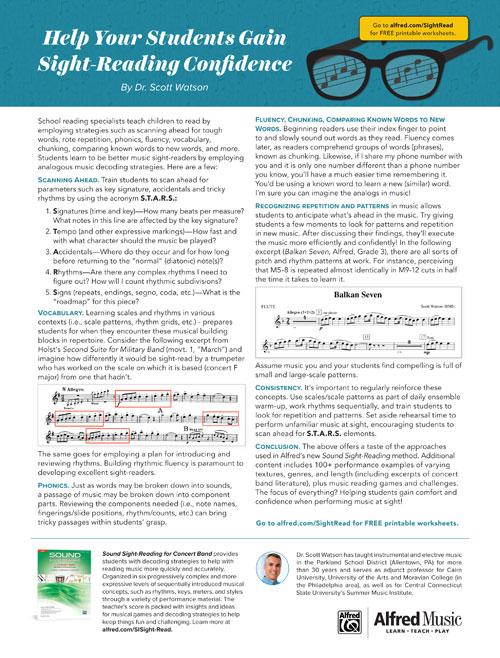To discuss the interpretation of music is the most difficult of all pedagogical efforts because it does not fall into the category of technique, and we bandmasters are known for our mastery of the technical. Interpretation resides in a special world and can only be called forth by understanding a composition’s reason for being through the intent of its creator. The composer’s intent can never be understood technically, but only through an understanding of why it was created—what the work is trying to accomplish and where it is going. Real art is never created just to add to the sum total of anything; it is created for a reason. The reason, or what the music is trying to do, is the key.
Music was present many thousands of years before it was elevated to the level of art, much later than its companions of literature, sculpture, drama, and painting. Its status as an art is actually quite recent if several hundred years is considered recent in comparison to thousands of years for literature. The pre-art existence of music relegated it to song and dance, and it is no surprise that early concert music and words were almost inseparable. In music with words the interpretation is usually self-evident. It was with the coming of purely instrumental concert music that a conductor, and later an interpreter, was necessary.
Scarlatti wrote 51 operas, and a hundred years later Beethoven wrote one, but nine symphonies. While Scarlatti’s music was supported by the church or the patron system, Beethoven had to fill a theater with purely instrumental music, without words to guide them. It is evident the attraction of drama, painting, and literature to the populist, but what is the appeal of purely instrumental music? I believe that without good and logical interpretation this appeal is completely lost, especially for music composed in the last two hundred years. Not only is the appeal lost but a level of boredom can be created that is unattainable in the other arts. I have never seen a painting as boring as a boring piece of music. This is partly caused by individual choices on the length of time spent with a painting, while with music you are trapped by time determined by someone else.
Although there are many boring compositions, any work can be lowered to that level by poor interpretation, especially in the 20th century literature. Boredom in the classroom is the greatest crime a teacher can commit. In music it is death.
Berlioz wrote in his treatise on conducting:
“Among creative artists the composer is almost the only one depending upon a host of intermediaries between him and the public—intermediaries who may be intelligent or stupid, friendly or hostile, diligent or negligent. It is in their power either to carry his work on to brilliant success or to disfigure, debase and even destroy it.
“Singers are often considered the most dangerous of these intermediaries; I believe that this is not true. In my opinion, the conductor is the one whom the composer has most to fear. A bad singer can spoil only his part, but the incapable or malevolent conductor can ruin everything."
When a close friend of mine is judging and hears a terrible band attempt one of my pieces, they love to send a copy of the tape to me. When I see them they always ask how I felt when I heard it. They are surprised when I reply that it didn’t bother me. It doesn’t bother me at all, because everyone who heard that band knew something on stage was horribly wrong. What does bother me, I should say tears my heart out, is when a great band with superb pitch, excellent balance, and all the techniques plays a piece of mine and completely misses the interpretation. This is so upsetting because the audience does not know anything is wrong with the band and assumes something is wrong with the composition. When the interpretation is missed with a 19th century work, it just seems dull; but if it is missed with a 20th century piece, it sounds silly and awkward.
A potentially great film can be destroyed by the cutters. If it is cut well there is a logical and dramatic sense of the occurrence or progression of events. If it is cut poorly the logic of occurrence is confused (e.g. Heaven’s Gate). In a well-cut film the form cannot be changed by the viewer or projectionist because the time element is unchangeable. In music this is the case only with electronic music on tape. When a musical work is "cut" well the form will be good, but the time element is at the discretion of each conductor.
In discussing the elements of interpretation, tempo would seem to be the simplest to correct or perform right, but it is the one element that if incorrect will destroy a good work immediately. In 19th century music tempo is usually indicated by terms. In the 20th century it is more specifically denoted with actual metronome markings. How, then, can there be any mistake in tempo in a work marked by a metronome indication? Easily.
First, composers very often put the wrong tempo on their music. This would seem impossible, but the tempo that seems best at the writing desk is very seldom the best on the podium. Most composers are not conductors, and the true tempo for a work can only be felt in a physical performance. Tempo is like water, it seeks its own level and this seeking only occurs in actual performance.
To avoid this problem I never publish a metronome marking until I have conducted the work at least five times in public performances. I say public performance because this is not always the same feel as at rehearsals.
Shostakovich marked the opening of his Symphony No. 5 as eighth note = 76—a very specific marking. Dimitri Mitropoulos, who I consider the best interpreter of Shostakovich, took it at 94 and then sped up six to eight counts at rehearsal number 2. This is a major discrepancy of about 20 counts between composer and conductor. Why did Mitropoulos do this? Because he felt it is the best tempo, and I agree it is the most logical and musical.
Much band music and some orchestral tempi are chosen by the conductor solely from the gymnastics approach. At a concert last year two conductors seemed intent on showing how fast the outstanding band could play. The performance was a musical disaster by a great band solely because of tempo. I judged a tape this year in which the percussion variation in James Barnes’s Paganini Variations was impeccably performed at almost twice the tempo it should have been played. It caused this wonderful variation to sound silly.
Why are so many band conductors, and soloists, concerned with speed over music? I include soloists because as the conductor of the Arkansas Symphony, I directed many concerts with guest soloists. I can’t remember a soloist wishing to take a tempo too slow, but often too fast. I once was forced to conduct the finale of the last movement of the Tchaikovsky Violin Concerto (last Tempo Primo to the end) in a fast one at the soloist’s insistence. Why did the performer insist on a tempo that was musically disastrous? He wanted the audience to applaud what Furtwängler referred to as a "gymnasium performance." Furtwängler also said, "When a person recites a poem or gives a lecture, he endeavors in the first instance to enunciate the words in such a manner that their sense is intelligible." Wagner, in his book on conducting, states, “His choice of tempi will show whether he understands the piece or not.”
How does one determine the correct tempo? A great first step is to sing it! I repeat for emphasis, sing it. Wagner said that it is almost impossible to choose the wrong tempi if you sing it. You have heard the first four notes of the Beethoven Fifth many different ways, some with the first three notes fast, short and clipped, others with the first three notes too long and exaggerated rubato with a huge space before the fourth note. Sing those four notes out loud while conducting, and it is difficult to do them wrong.
Wagner said, "Our conductors so frequently fail to find the true tempo because they are ignorant of singing. These people look upon music as a singularly abstract sort of thing, an amalgam of gram-mar, arithmetic, and digital gymnastics."
Involved in tempo is the choice of rubato. William F. Santleman once told me after I had complimented his rubato in Andrea Chenier, "You can’t teach rubato. A conductor can either do it or he can’t." I think I agree that it probably cannot be taught, but musicianship and musicality may be, and it is the guiding factor in rubato.
Although tempo is the Achilles heel in interpretation, volume variants is the Moriarty, the ever present hidden nemesis. When I speak of volume variants, many think that I am talking only of playing loudly or softly. Volume variants include so many aspects of playing—articulation, the accent is a volume variant; phrasing, the phrase ending is a volume variant; the complete curve of a phrase is a volume variant, the crescendo, the decrescendo, the timpani volume, and just plain louds and softs.
The composer primarily speaks through volume variants and dissonance with melody and rhythm a distant second. I have sat many times with composers as they listen to their own works. They always mumble throughout the entire performance. The mumbling invariably goes like this:
"Too fast—louder trombones, louder—too loud trumpets—come on timpani, we can’t hear that—no, no sffzp, band, sffzp—can’t hear the tubas." When it’s one of my works, my wife has to listen to all the mumbling.
I never hear composers mumble, "Oops, the I flutes are sharp—poor subdivision in the clarinets—brass balance is poor”; they always speak of tempi and volumes. This tells me that composers and most band directors are primarily concerned about two different aspects of the performance: the director with technique and the composer with interpretation. The performance should have both; but no matter how good the band is, poor interpretation destroys the music, poor technique only hurts it.
Why are volumes so difficult to sense? One seldom hears the Brahms Second performed with different volume concepts, but you surely will with Fanfare and Allegro. I have never heard a composer conduct one of his pieces without pleading for more volume from the timpanist. Most high school timpanists just can’t play at a fortissimo, and it’s so easy. The same is true for horns.
After I have rehearsed an all-state band for two hours, I invariably hear from a player or band director, "Oh, you want the horns and timpani to play real loud," to which I reply, "No, not at all. I want the same volume at an ff from them that Hanson wants in his music or Ansermet uses in Stravinsky. I want the same timpani volume at ff that the timpanist in the Chicago Symphony uses." It’s not a matter of skill or technique, experience, or age.
Correct interpretation is the re-creation of the composer’s intent. As I said before, in music with text the intent is more obvious. In purely instrumental music the conductor must understand what the composer is trying to accomplish, what problem he is trying to solve. Stravinsky said, "I cannot compose until I have decided what problem I must solve." I would state it differently: I cannot compose until I have decided what effect I wish to achieve.
The effects that I am trying to achieve are not mysteries known only by the chosen. Ninety percent are written on the page. When I use the term "composer’s intent," I am not speaking of some hidden meaning or an idea that is difficult to comprehend: I mean primarily what is written on the paper. Many times I have said to high school honor bands, always on the first day, that they should consider a career as band clinicians. It is good travel, you meet wonderful people, and you don’t have to know anything. You just show up and tell the musicians what is printed on their parts. This is an oversimplification, but not by much.
In my work Masque (pronounced Mask, by the way, not Mosque) there are two measures that I have seldom heard done correctly. There are two adjacent measures in which the band has an sffzp crescendo to ff over three beats at a tempo of 156. Most bands will not get down to the p or up to the ff because it happens so fast. When I point this out in clinics, I play a tape of it being done perfectly by a high school band from Kaho, Japan. The extreme quick change of volume is so exciting, and invariably someone will say, "How do we know that is the effect you want?" I reply, "How else can that marking be done? I know of no other way." It’s printed on the paper; a sfmf crescendo to f is wrong. A director would never change a note or chord, but they frequently change the volumes. The volumes are more important than the notes. The problem is that most conductors think they are performing them correctly. There are seldom inconsistencies with orchestral directors, yet I wonder why there are the extreme differences among band directors. Could it be that so many young bands are not mature enough to handle the literature they attempt to play?
The effect to be achieved is not difficult to understand. The difficulty is in the degree of drama that various conductors choose to achieve it. Musical nuance must be exaggerated. From the composer’s pen to the conductor, through the ensemble to the audience, so much can be lost in the translation. Art is not an experience of reality; it is one of exaggeration.
If nuance is underplayed, music withers into just acoustical pitches that don’t offend. Exaggerated nuance affects the listener in a myriad of responses, none of which is boredom.
I do not wish to leave the impression that a given work is supposed to be the same no matter who conducts it. There can be a wide range of personal variations of interpretation by different conductors. This is one of the great enjoyable advantages that orchestrated music, performed by humans, has over electronically produced tape music. There are sections in certain works that I have chosen to perform differently than anyone else. This is my artistic prerogative, but it seldom has to do with tempo and never with volumes or specifically designated markings.
It is in tempo and specific markings that the interpretation of band music suffers so. Don’t forget why you became a musician. It was because of a love affair with sound. It was not from a love affair with organization, techniques, or competition, no matter how commendable these efforts may be. A musical experience has no substitute; and when it is experienced by the band, the conductor, and the audience, it is desired above all else.







